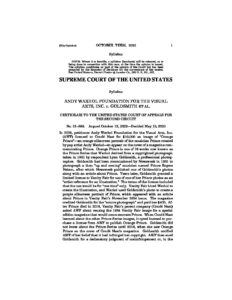By Kevin C. Parks
Writing for a 7-2 U.S. Supreme Court majority in Andy Warhol Foundation for the Visual Arts, Inc. v. Goldsmith, Justice Sonia Sotomayor placed speed bumps on the so-called “transformative” fair use defense in copyright law, a correction that returns the four-factor fair use inquiry to the text of the statute, 17 USC §107.
The case involved the Warhol Foundation’s commercial licensing of “Orange Prince”—an image in the late artist’s Prince Series, which was based on a black and white photo of the pop music icon taken by the trailblazing rock-and-roll photographer Lynn Goldsmith. When confronted with the unauthorized use, the Foundation sued, seeking a declaration that its use was “fair” as a matter of law, because Warhol’s version added new meaning and expression and was therefore “transformative.” The district court agreed, granting summary judgment for the Foundation.
The Second Circuit reversed, emphasizing the negative effect the Foundation’s use could have on the potential licensing market for the original photo, and criticizing the recent trend toward finding “transformative” and thereby “fair” use whenever an allegedly infringing copy can be said to add some degree of “new expression, meaning or message” to the original.
On appeal, the Supreme Court addressed the narrow question of “whether the first fair use factor, ‘the purpose and character of the use, including whether such use is of a commercial nature or is for nonprofit educational purposes,’…” weighed in favor of the Foundation. Answering “no,” the majority found that the purpose and character of the Foundation’s use of Orange Prince was purely commercial–a fee-generating license to publish the image in a magazine–and that such use essentially placed Orange Prince in direct competition with Goldsmith’s original photo.
The Court found that the aesthetic question of whether a copy is “transformative” may be relevant to determining purpose or character of the use, but it is not, without more, dispositive of the first fair use factor. By this reasoning, the majority articulated the inherent tension between “transformative fair use” (a judge-made doctrine first articulated in a 1990 law review article), and the copyright owner’s statutory, exclusive right to create “derivative works”– those in any form in which a work may be recast, “transformed,” or adapted. The majority concluded that an “overbroad concept of transformative use, one that includes any further purpose, or any different character, would narrow the copyright owner’s exclusive right to create derivative works.”
Justice Gorsuch’s concurrence (joined by Justice Jackson) essentially eliminated the “transformative” debate altogether, framing the question as a “modest inquiry focused on how and for what reason a person is using a copyrighted work in the world, not on the moods of any artist or the aesthetic quality of any creation.”
Justice Kagan (joined by Chief Justice Roberts) issued an impassioned and pointed dissent, accusing the majority of ignoring or abandoning the high court’s most recent fair use decisions--Campbell v. Acuff-Rose Music, Inc., 510 U.S. 569 (1994), and Google LLC v. Oracle America, Inc., 593 U.S. __ (2021)--in which transformative fair use was found in the context of musical parody and computer software, respectively.
Labeling Andy Warhol “the avatar of transformative copying,” the dissent argued that the salient inquiry on the first fair use factor is how Warhol himself used the original photo in creating Orange Prince, not how the artist’s Foundation used the work some years later.
I submit the same result can be reached regardless of whether the analysis is focused on the purpose and character of Warhol’s use or the Foundation’s, as both emerged from a highly commercial context that tilts the first fair use factor in favor of the author of the original work.
Purple Prince
Goldsmith took her original photo of Prince in 1981. In 1984, Goldsmith licensed that photo to publisher Conde Nast, for a “one time” use as an “artist reference for an illustration” in Vanity Fair magazine. In turn, Conde Nast “commissioned” Warhol to create an illustration of Prince based on the licensed photo. The result was “Purple Prince,” published in the November 1984 issue of Vanity Fair, to accompany “Purple Fame,” Tristan Vox’s story of Prince’s artistic rise, in the wake of his breakthrough autobiographical film and soundtrack album Purple Rain.
Few music-minded Americans–let alone Andy Warhol, who lived on the cutting edge of popular culture–remained unaware of Prince’s rise in 1984. And while the artist’s rendering of Purple Prince bears all the earmarks of a “Warhol,” it was nonetheless a commissioned product, based on a specific (licensed) photo, part and parcel of a commercial transaction. The purpose and character of Warhol’s use was to deliver a portrait of Prince per his contract with Conde Nast.
The Prince Series
Warhol did not stop with Purple Prince—he used the same photo (beyond the terms of Goldsmith’s license to Conde Nast) as the basis for fifteen additional works, including Orange Prince, which together became known as the Prince Series.
Andy Warhol died in 1987, and his copyrights were transferred to his Foundation, whose mission statement, reflected in the court record, includes “preserving Warhol’s legacy through creative and responsible licensing policies.”
Following Prince’s untimely death nearly thirty years later, the Foundation granted a license (coincidentally, again to Conde Nast) to use Orange Prince as the cover of a postmortem magazine tribute, The Genius of Prince. The Foundation received a license fee of $10,000, which was not shared with Goldsmith. The Foundation’s licensing of Orange Prince was the subject of the litigation.
Focusing on the Foundation’s act of licensing Orange Prince, the majority concluded that the “purpose and character” of the use was dominated by commercial interests. The dissent insisted that the focus should be on Warhol’s initial rendering of the illustration, but the court record aptly demonstrates that his creative acts were part of the same set of commercial transactions. The Foundation’s coyness regarding Warhol’s access to the Goldsmith photo is telling. Despite all the underlying agreements, and copyright attribution to Goldsmith’s image as the “source photograph,” at the district court level the Foundation argued that there was “no evidence” that Warhol was given the licensed photograph to work from.
It is abundantly clear that Warhol was not working in an artistic vacuum, for the sake of art only, in creating the Prince Series. Rather, inspiration struck by virtue of Goldsmith licensing her photo to Conde Nast, who then paid Warhol a commission to use that photo to create an illustration for use in a magazine. Given this context, the purpose and character of Warhol’s use (like the Foundation’s) can be seen as overwhelmingly commercial, with any transformative changes attributable to commercial, as well as artistic, processes.
In the end, the Warhol opinion is a limited holding that narrows the fair use defense and returns the inquiry to the plain text of the statute, with little risk of chilling the creative instincts of appropriation artists, or any other class of creators.


